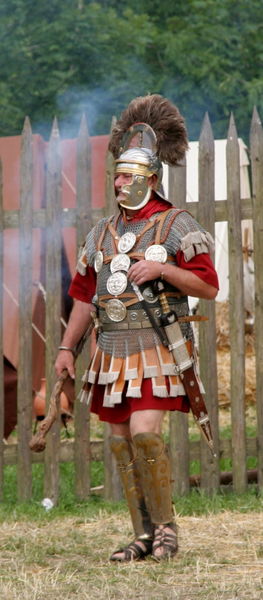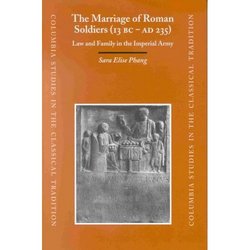The Roman marriage ban prohibited marriage for serving Roman soldiers
 |
A Roman Centurion
According to Dr. Sara Phang, the Roman marriage ban, instituted by Augustus before the birth of Christ, lasted until AD 197, when Septimius Severus ended it. Remember, our topic is the Roman Centurion and his pais.
We are investigating whether Matthew, Luke and the Holy Spirit, in Matthew 8:5-13 and Luke 7:1-10, intentionally used the Greek word pais with the meaning of “beloved or same sex lover.”
To support her assertions about the Roman marriage ban, Dr. Phang relies in part, on the Egyptian Cattaoui papyrus, a second century Greek document which summarizes seven trials held between AD 114-142. In these trials, Roman prefects judged the marriages of Roman soldiers illegal because they sired children while in Roman service. Phang traces the Roman marriage ban through Greek and Latin papyri and clay tablets from Roman Egypt.
The Marriage Of Roman Soldiers, (13 BC-AD 235): Law And Family In The Imperial Army, Sara Elise Phang, Brill Academic Publishers, 2001, p. 2.
The Roman marriage ban
in the first century A.D.
 |
The Marriage Of Roman Soldiers, 13 BC - AD 235,
by Sara Elise Phang
During the ministry of Christ, in the time frame in which New Testament events occurred, a serving Roman soldier was not allowed to enter a legally recognized marriage with a woman. This was the Roman marriage ban.
Michael Grant, in The Army of the Caesars, on page 78, cites Salvatore Riccobono in Fontes iuris romani antejustiniani, 2nd edition, p. 111, 119.
"Soldiers were not allowed to marry during service, and if they were already married when they joined the army their marriages had to be dissolved. This was in accordance with the theory that they would often be on the move - or, perhaps, that they must not become soft, and distracted from their jobs."
The Army of the Caesars, Michael Grant, Charles Scribner's Sons, 1974, p. 78, 314.
Four important reasons
for the Roman marriage ban
- Many Roman soldiers were not Roman citizens, therefore they could be accorded fewer legal rights than Roman citizens. The Roman marriage ban denied all soldiers the right to legal marriage while they served in the Roman army.
- Marriage among soldiers was viewed as an expense which government need not subsidize. The Roman upper classes deplored heterosexual soldier marriage and the problems it caused the army, as feminizing the Roman legions. The Roman marriage ban was seen as a corrective measure against the feminization, which impeded effectiveness of the Roman army as a fighting unit, thus, the ban on marriage for serving Roman soldiers.
- The Roman marriage ban was seen as a way to restore discipline to the Roman legions after the turmoil of the Roman civil war.
- The Roman marriage ban symbolically differentiated between soldiers and civilians while emphasizing soldiers as the ideal of Roman manhood.
 |
The Roman Marriage Ban for Legionaries
A Roman Soldier
This is discussed at this Link. Scroll down to: 110509 - "Marriage, families, and survival in the Roman imperial army: demographic aspects. Walter Scheidel, Stanford University."
Alternative sexual relationships as a
result of the Roman marriage ban
- Sexual relationships with locals, both female and male.
- Frequenting prostitutes both female and male.
- Sexual relationships with slaves both female and male.
(Phang, The Marriage Of Roman Soldiers, Chapter Eight, Heterosexual Relations Outside Marriage, p. 229-261.)
 |
Roman Centurion Helmet
Roman soldiers during the Roman Republic habitually brought their personal slaves along on campaigns. This behavior continued into the Roman Empire, during the ministry of Christ and at the time the New Testament was written.
Matthew and Luke were familiar with this practice because they mention it in their Gospels, Matthew 8 and Luke 7. Historical evidence indicates it was not unusual even for common soldiers, to bring personal slaves on Roman army campaigns. Tacitus, in AD 69, reports that Vespasian’s army of 60,000 soldiers also had more than 60,000 camp followers and slaves. Complete Works Of Tacitus, 1942, Book II.87 History, March-August, AD 69.
In the early days of the Roman Republic, 527-510 BC, homosexual relationships were officially banned, although these bans were frequently ignored under the Republic and during the first and second centuries AD, when the Roman Republic had become the Roman Empire.
Because the Roman army needed soldiers, many non-citizens from conquered provinces became Roman soldiers. The low social standing of these non-citizens, the ban on legally recognized heterosexual marriages for serving soldiers and classic Roman indifference to homosexuality at this time in history encouraged same sex relationships in the Roman army of the first century.
 |
Classic Roman Centurion
Sexual activity between men was tolerated and male prostitution was taxed by the Roman government. At the time the New Testament was written, the Greek word pais was commonly used to describe one of the partners in a same sex relationship. As an important part of the Roman Empire, Israel was exposed to Roman culture, with its Greek language and Greek sexual mores. By the time Matthew wrote his Gospel, Greek civilization had, for six centuries, recognized sexual relationships between men.
These relationships were celebrated in literature, art, law and social custom. Ceiling, floor and wall murals, vase paintings, carvings and statues, plays and poetry, even graffiti, depicted sexual relationships between men. In this cultural and historical setting Matthew and Luke used the Greek word pais to describe the partner of the centurion.
This cultural and historical information does not, by itself, prove or disprove that the Roman centurion in Matthew 8:5-13 and Luke 7:1-10, was a gay man. It does accurately depict the cultural, historical and linguistic context for us. And it does provide a basis for making a common sense judgment that this Roman centurion probably was in a same sex relationship with his pais, his beloved servant.
Real world citizens of the first century Roman Empire, in which Matthew and Luke put the Greek word pais in the mouth of the Centurion, would not have missed the idiomatic implications of pais. Using the Greek word pais to describe the servant of a Roman centurion is like exclaiming:
“He’s a hairdresser in San Francisco!”
Our Common Sense Conclusion
One need not be gay or theologically liberal to believe that Matthew, Luke and the Holy Spirit intended the story of the Roman Centurion and his pais as a lesson in how to treat those whom many choose to view as social outcasts.
Helpful links to additional information
Jonathan and David
two military men in love
Does pais mean gay male lover?
Is there a gay centurion
in the Gospel of John??
From Roman marriage ban Return To
Gay Christian 101.com Home Page.
Grab our incredible book
Gay Christian 101
Christians are not required to
keep the Law to be right with God
This page updated January 30, 2017
Google Translate
into 90 languages
We are saved:
by grace alone through faith alone
Recent Articles
-
Gay Christian 101 - Affirming God's glorious good news for all LGBs.
Jan 08, 24 12:57 AM
Gay Lesbian Bisexual Christian 101 - Accurate biblical and historical info defending LGB Christians from the anti-gay crowd. -
Romans 1 describes ancient shrine prostitution, not gays and lesbians.
Dec 21, 23 04:37 PM
Romans 1, in historical context, is about ancient Roman fertility goddess worshipers who engaged in shrine prostitution to worship Cybele, not gays and lesbians. -
The Centurion And Pais - When Jesus Blessed A Gay Couple.
Nov 14, 23 10:32 PM
Centurion and Pais? If Jesus blessed a gay relationship, would this change your view of homosexuality?
Bible Study Resources
for eDisciples





